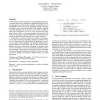Free Online Productivity Tools
i2Speak
i2Symbol
i2OCR
iTex2Img
iWeb2Print
iWeb2Shot
i2Type
iPdf2Split
iPdf2Merge
i2Bopomofo
i2Arabic
i2Style
i2Image
i2PDF
iLatex2Rtf
Sci2ools
AOSD
2015
ACM
2015
ACM
Essential retroactive weaving
To help analyze unexpected behaviour, programming language environments and tools are beginning to support high-fidelity recordings of program executions. Such recordings are typically low-level and difficult to work with directly. Debugging and analyzing these recordings is easier and more powerful if it is possible to simulate executing additional code in the past context of the recording. In prior work we proposed retroactive weaving, the process of evaluating aspects as if they were present during a past execution. This concept is intended as a general framework for introducing additional code and defining the semantics of executing it post-hoc. In this paper we express retroactive weaving as a transformation on aspect-oriented programming languages and their semantics. We demonstrate this transformation by applying it to a simple core aspect-oriented language, and through a definitional interpreter illustrate its interactions with first-class function values, mutable state, ...
Related Content
| Added | 16 Apr 2016 |
| Updated | 16 Apr 2016 |
| Type | Journal |
| Year | 2015 |
| Where | AOSD |
| Authors | Robin Salkeld, Ronald Garcia |
Comments (0)

